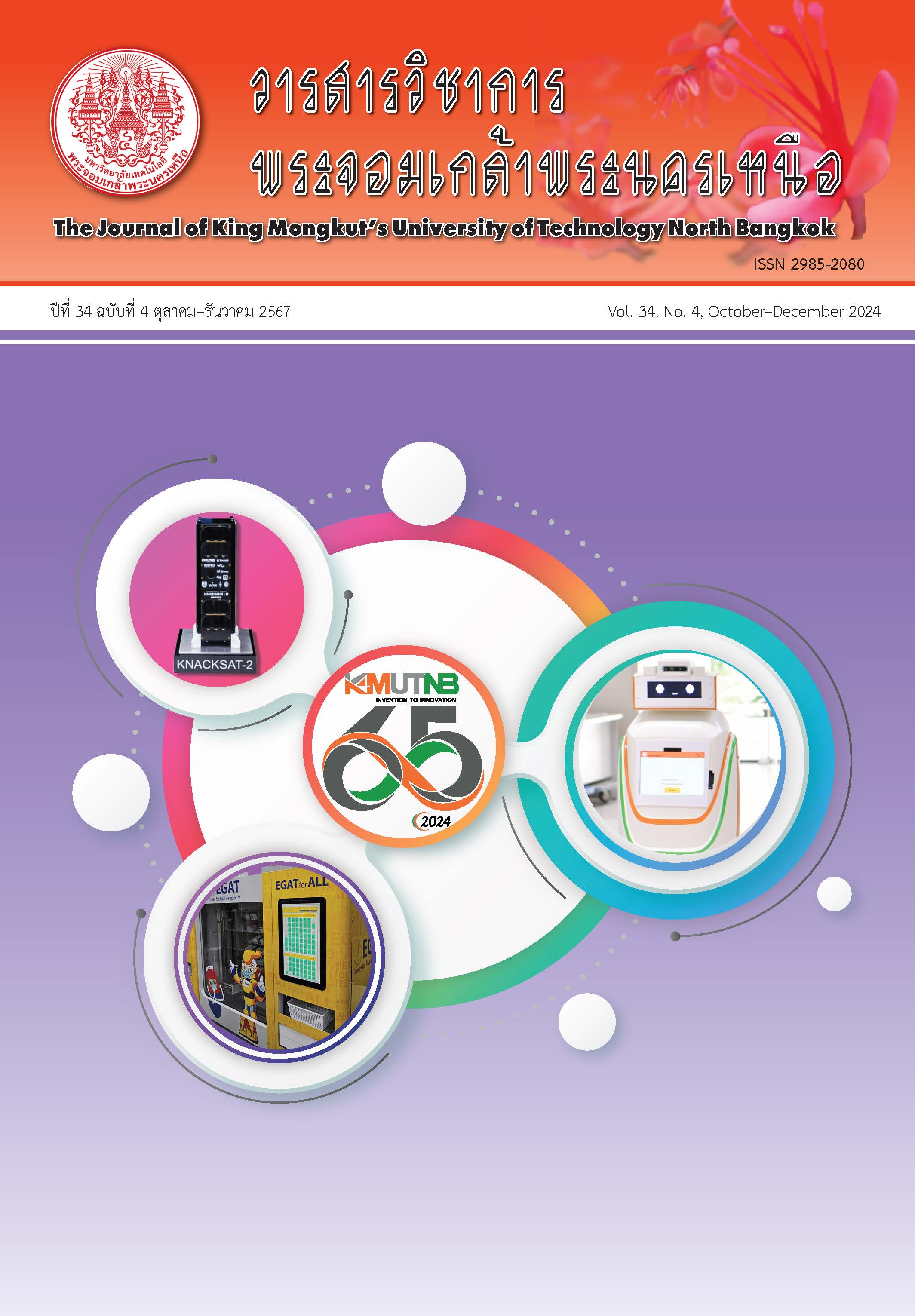การพยากรณ์ความต้องการและนโยบายการเติมเต็มพัสดุคงคลังแบบพอดีกับความต้องการสำหรับชิ้นส่วนอะไหล่เครื่องจักรกลการเกษตร
Main Article Content
บทคัดย่อ
เครื่องจักรกลการเกษตรเป็นอุปกรณ์ที่สนับสนุนการทำงานของเกษตรกร เพื่อเพิ่มประสิทธิภาพและความรวดเร็วในการทำงาน แต่เนื่องจากอุปกรณ์มีอายุการใช้งานที่จำกัดและอาจได้รับความชำรุดเสียหาย หรือสึกหรอจากการใช้งานได้ จึงจำเป็นต้องมีการเปลี่ยนชิ้นส่วนอะไหล่เพื่อทดแทนความเสียหายอยู่เสมอ ดังนั้นผู้ให้บริการหลังการขายเครื่องจักรกลการเกษตรจึงต้องเตรียมพร้อมเพื่อตอบสนองต่อความต้องการชิ้นส่วนอะไหล่อยู่เสมอ เพื่อให้สามารถให้บริการลูกค้าได้อย่างรวดเร็วและมีประสิทธิภาพ จากการวิเคราะห์ความต้องการชิ้นส่วนอะไหล่ของบริษัทกรณีศึกษาพบว่า รูปแบบความต้องการของชิ้นส่วนอะไหล่มีลักษณะไม่คงที่และไม่สามารถทราบล่วงหน้าได้ เพื่อให้สามารถรองรับความต้องการของลูกค้าได้ การเติมเต็มพัสดุคงคลังจึงมีความสำคัญอย่างยิ่งต่อการจัดการพัสดุคงคลังเพื่อให้สามารถตอบสนองต่อความต้องการอะไหล่ของลูกค้าได้ทันเวลา งานวิจัยนี้ได้ศึกษาปัญหาที่เกิดขึ้นในบริษัทกรณีศึกษา โดยได้ปรับปรุงวิธีการที่ใช้ในการพยากรณ์ความต้องการชิ้นส่วนอะไหล่ให้มีความแม่นยำขึ้นโดยใช้เทคนิคการพยากรณ์แบบอนุกรมเวลาที่เหมาะสมกับรูปแบบความต้องการชิ้นส่วนอะไหล่ จากนั้นกำหนดนโยบายการเติมเต็มพัสดุคงคลัง โดยได้กำหนดตัวชี้วัดประสิทธิภาพจากอัตราการตอบสนองต่อคำสั่งซื้อของลูกค้า และอัตราการขายสินค้าคงคลัง ผลการวิจัยพบว่า การนำเทคนิคการพยากรณ์แบบอนุกรมเวลาและการกำหนดนโยบายการเติมเต็มพัสดุคงคลังแบบพอดีกับความต้องการในแต่ละคาบที่มีรอบการตรวจสอบรายวัน มาใช้กับกลุ่มชิ้นส่วนที่มีรูปแบบความต้องการแบบมีฤดูกาลและแบบมีแนวโน้มโน้มพร้อมทั้งฤดูกาลสามารถเพิ่มอัตราการตอบสนองต่อคำสั่งซื้อของลูกค้าขึ้นได้โดยเฉลี่ยร้อยละ 18.85 และร้อยละ 23.23 ตามลำดับ
Article Details

อนุญาตภายใต้เงื่อนไข Creative Commons Attribution-NonCommercial-NoDerivatives 4.0 International License.
บทความที่ลงตีพิมพ์เป็นข้อคิดเห็นของผู้เขียนเท่านั้น
ผู้เขียนจะต้องเป็นผู้รับผิดชอบต่อผลทางกฎหมายใดๆ ที่อาจเกิดขึ้นจากบทความนั้น
เอกสารอ้างอิง
J. Jully, “Demand forecast accuracy and performance of inventory policies under multi-level rolling schedule environments,” International Journal of Production Economics, vol. 103, pp. 401–419, 2006.
M. Masoud, “Integrating ABC analysis and rough set theory to control the inventories of distributor in the supply chain of auto spare parts,” Computers & Industrial Engineering, vol. 139, no. C, 2020.
P. Khemavuk and C. Chawbangkaew, “The study of an optimal smoothing constant value for data with no trend and seasonality behavior,” The Journal of KMUTNB, vol. 31, no. 2, pp. 245–256, 2020 (in Thai).
P. Komkul, “Forecasting cassava starch price in thailand by using time series models,” The Journal of KMUTNB, vol. 27, no. 4, pp. 805–820, 2017 (in Thai).
P. Ramos, N. Santos and R. Rebelo, “Performance of state space and ARIMA models for consumer retail sales forecasting,” Robotics and Computer-Integrated Manufacturing, vol. 34, pp. 151–163, 2015.
S. Chanbunkaew and W. Tharmmaphornphilas, “Forecasting of incoming calls in a commercial bank service call center,” in Proceedings of the 10th International Conference on Computer Modeling and Simulation, Sydney, 2018, pp. 281–284.
A. Junvadee, “Improvement of demand forecasting and replenishment policy of raw materials for an engineer-to-order cast iron manufacturer,” in Industrial Engineering Network Conference 2018, Ubon Ratchathani, 2018, pp. 1392–1399 (in Thai).
A. Vereecke and P. Verstraeten, “An inventory management model for an inventory consisting of lumpy items, slow movers and fast movers,” International Journal of Production Economics, vol. 35, no. 1–3, pp. 375–389, 1994.
P. Penpakkol and T. Intarakumthornchai, “Inventory management of spare parts under uncertain demand: a case study of particle board manufacturer,” The Journal of KMUTNB, vol. 28, no. 1, pp. 9–22, 2018 (in Thai).
P. Chaovalitwong, Determining Inventory Policy Theories And a Systematic Thinking Approach, Bangkok: Chulalongkorn University Printing House, 2018 (in Thai).
H. Li-Ting, H. I-Chien, and F. Cheng-Kiang, “On ordering adjustment policy under rolling forecast in supply chain planning,” Computers & Industrial Engineering, vol. 60, no. 3, pp. 397–410, 2011.
R. Herrin, “How to calculate safety stocks for highly seasonal products,” The Journal of Business Forecasting, vol. Summer, vol. 24, no. 2, pp. 6–10, 2005.
P. Parthanadee and S. Suktor, “Safety stock levels for products with seasonalityor high variability in demand,” Kasetsart Journal of Social Sciences, vol. 33, no. 3, pp. 442–453, 2012 (in Thai).
J. R. Kroes and A. S. Manikas, “Cash flow management and manufacturing firm financial performance: A longitudinal perspective,” The Journal of Production Economics, vol. 148, pp. 37–50, 2013.

